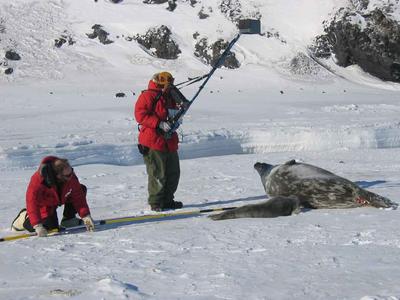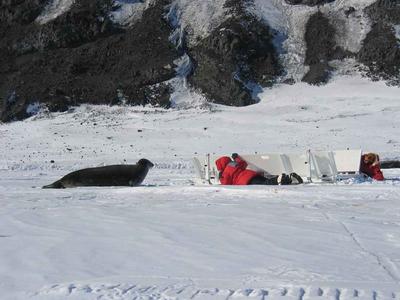25 October, 2003
The good news is that the seal-weighing sled is now fully functional.
The bad news is that we now have a full-service weighing station that
is accurate to within a few grams, parked immediately outside our
door. It might make us think twice about grabbing that extra Oreo
off the plate in our quest for caloric gratification!
Darren spent a day in McMurdo unraveling the mystery of the weighing
sled. The problem turned out to be strictly mechanical. The four
load sensors, fixed under the corners of the weighing platform, are
contained within welded metal brackets. While they were fully
functional at 72F when the sled was tested in the United States, they
didn't work properly after a night spent in the cold of Antarctica.
Why? Well, metal contracts when it cools-the brackets became too
tight and didn't allow the sensors to move within their housing.
Once He determined that this was the problem, it was a matter of
grinding the brackets down a bit to ensure that the sensors could
move freely even after the metal contracted in the cold. There are
many lessons to be learned here. The first is that Antarctica is a
harsh environment that severely tests your equipment-Murphy's Law
rules in Antarctica. The second lesson is that the simpler the piece
of equipment, the easier it is to identify and fix problems. The
sled's construction is simple-there are few moving parts and anything
sensitive to moisture and freezing is enclosed in a weatherproof
housing. The third, and most important, is the need to be very
familiar with how a parcticular piece of equipment works. In this
case, Darren had designed the sled, so knew where each component was
located and how it was supposed to work. Basically, it all comes
down to using that most basic of all scientific tools, the scientific
method, as you systematically work through the mystery and develop
and test a series of hypotheses until the root problem is identified.
Of course, in Antarctica you hope that the problem is one that can be
fixed in a land of limited resources.
The process for photographing and weighing the seals is pretty
straightforward. Using a boom-mounted digital camera (the pictures
at the end of this journal will help you understand what that looks
like) you take pictures of both the mother and its pup. A stick,
marked in 20 cm intervals, is included in the photo for use as a
scale during analysis. Photographs are taken of the seal from above
and from the side. Once all the seals are photographed, it's time to
weigh them. The scale is pulled into place with a snowmobile, set
into position, and is ready to go.
Okay, enough for theory, here's how it really works. A number of
factors conspire to make each step as difficult as possible. First
of all, you need to remember where you are-it's Antarctica. What
does that mean? It's cold and windy and the snow surface is anything
but level. It's difficult to hold a camera attached to a 5-foot long
boom steady in the best of conditions. Now imagine doing that when
the wind is blowing at 15-20 mph. Then there's the issue of manual
dexterity needed to operate the camera. Usually you wear a thin pair
of liner gloves underneath your warm gloves. The liners definitely
help with keeping your fingers flexible, but they don't do much to
keep them warm-the other crucial element needed for dexterity.
Consider the difficulties involved in keeping a digital camera
operating under cold conditions. Battery life is shortened and
electronics don't always work the way the manufacturer intended.
Then, there's the seals. Getting a seal to stay still for a photo is
kind of like asking a small child to sit still while you set up an
elaborate portrait shot. While some seals sit resignedly throughout
the process, most squirm about as you hover over them with a camera
and the scale stick. Both photographer and photographee jockey for
position in an elaborately choreographed dance.
The weigh sled is designed to give an accurate weight within seconds
of placing the animal on the scale. It averages the weights
determined by each sensor and displays the weight on a digital
screen. Getting a pup's weight is straightforward-drag the pup to
the sled and weigh them. Their mothers are a different story.
There's very little you can do to persuade a 400-500 kg animal to do
something it doesn't think is in its best interest. We work in teams
of three-one to get the pup to the sled and hold it on the scale
while the other two stand by to help guide the mother onto the sled
after her baby. When she is on the scale we remove the pup and read
her weight on the digital readout, then let her exit. Then we put
the pup back on to get its weight. After this we reunite mother and
pup on the ice and back off to let them settle down. Sometimes, no
matter what we do, the mothers just do not get on the scale. In
those cases we simply stop, weigh the pup, and end the ordeal before
either seal or researcher become overly stressed.
Today we were able to photograph and weigh 6 pups. Their mothers,
however, were a different story. While all were photographed, only
one deigned to get on the scale. Once a seal is photographed you
have 24 hours to weigh her. We will come back tomorrow after we
weigh the remaining pup/mother pairs to see if we can coax any more
moms onto the scale.
Daily Haiku
Photographing seals
Enticing them onto scales
Waddle right up please

Darren tows the weighing sled behind a snowmobile to an area near the seals

Darren has attached the camera and is ready to photograph seals.

Darren photographs the seal. Brent is holding a stick that has been marked in 20 cm intervals next to the seal for scale.

Darren drags a pup to the weighing scale.

Kelly and I hide behind the scale as the mother seal approaches.

The mother and her pup after they they have been weighed.
Contact the TEA in the field at
.
If you cannot connect through your browser, copy the
TEA's e-mail address in the "To:" line of
your favorite e-mail package.
|
